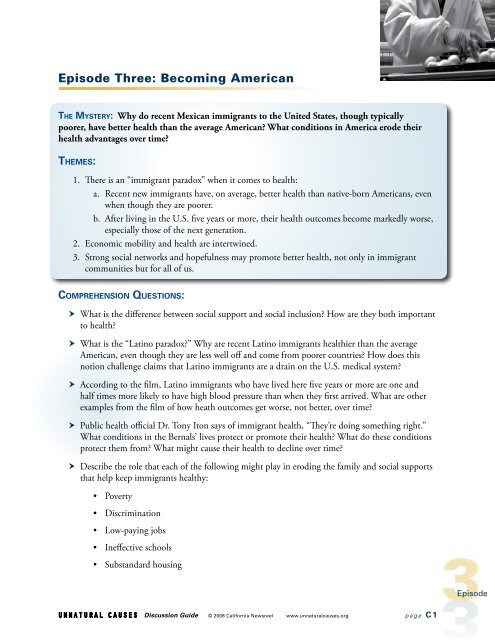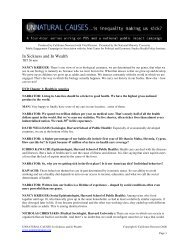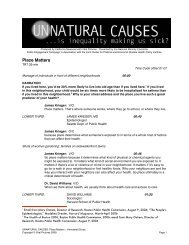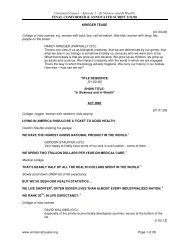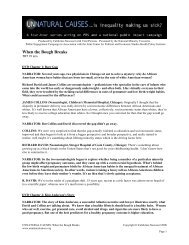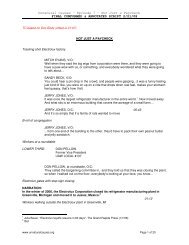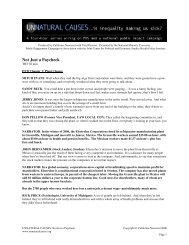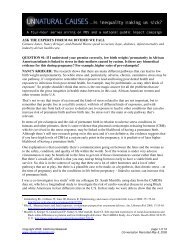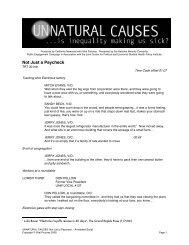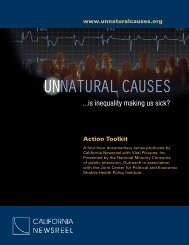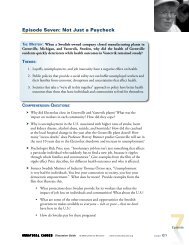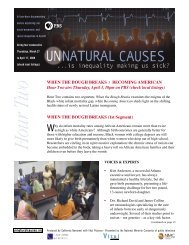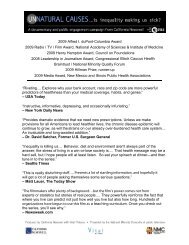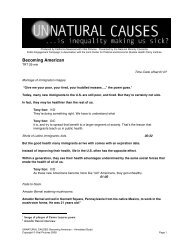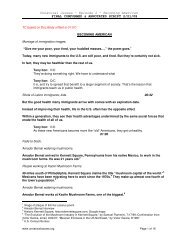Episode Three: Becoming American - Unnatural Causes
Episode Three: Becoming American - Unnatural Causes
Episode Three: Becoming American - Unnatural Causes
You also want an ePaper? Increase the reach of your titles
YUMPU automatically turns print PDFs into web optimized ePapers that Google loves.
<strong>Episode</strong> <strong>Three</strong>: <strong>Becoming</strong> <strong>American</strong><br />
Th e My s t e ry: Why do recent Mexican immigrants to the United States, though typically<br />
poorer, have better health than the average <strong>American</strong> What conditions in America erode their<br />
health advantages over time<br />
Th e m e s:<br />
1. There is an “immigrant paradox” when it comes to health:<br />
a. Recent new immigrants have, on average, better health than native-born <strong>American</strong>s, even<br />
when though they are poorer.<br />
b. After living in the U.S. five years or more, their health outcomes become markedly worse,<br />
especially those of the next generation.<br />
2. Economic mobility and health are intertwined.<br />
3. Strong social networks and hopefulness may promote better health, not only in immigrant<br />
communities but for all of us.<br />
Co m p r e h e n s i o n Qu e s t i o n s:<br />
What is the difference between social support and social inclusion How are they both important<br />
to health<br />
What is the “Latino paradox” Why are recent Latino immigrants healthier than the average<br />
<strong>American</strong>, even though they are less well off and come from poorer countries How does this<br />
notion challenge claims that Latino immigrants are a drain on the U.S. medical system<br />
According to the film, Latino immigrants who have lived here five years or more are one and<br />
half times more likely to have high blood pressure than when they first arrived. What are other<br />
examples from the film of how heath outcomes get worse, not better, over time<br />
Public health official Dr. Tony Iton says of immigrant health, “They’re doing something right.”<br />
What conditions in the Bernals’ lives protect or promote their health What do these conditions<br />
protect them from What might cause their health to decline over time<br />
Describe the role that each of the following might play in eroding the family and social supports<br />
that help keep immigrants healthy:<br />
• Poverty<br />
• Discrimination<br />
• Low-paying jobs<br />
• Ineffective schools<br />
• Substandard housing<br />
<strong>Unnatural</strong> <strong>Causes</strong> Discussion Guide © 2008 California Newsreel www.unnaturalcauses.org<br />
<strong>Episode</strong><br />
<strong>Episode</strong><br />
page C1<br />
<strong>Episode</strong>
Epidemiologist Lisa Berkman says: “Overall, people who are really isolated are at increased risk<br />
not only for cardiovascular disease, but for infectious diseases, for diabetes, for strokes, for cancer.<br />
They were at increased risk from almost every cause of death.”<br />
• What are the causes of social isolation and exclusion in America<br />
• Why are <strong>American</strong>s on average more socially isolated today than 20 years ago<br />
• How does a strong community network support social inclusion<br />
Di s c u s s i o n Qu e s t i o n s:<br />
Dr. Iton says, “When you’re a new immigrant, the relationship between wealth and health is<br />
relatively loose. As you become more <strong>American</strong>, that relationship becomes tighter and tighter<br />
and tighter.” What does he mean<br />
• What forces in society cause the tightening of that relationship<br />
• What interventions might prevent this from happening<br />
• What can we learn from immigrants that can help improve health for all <strong>American</strong>s<br />
Amador Bernal says: “I water the mushrooms with a hose and watering can by myself… I earn<br />
$9.03 an hour. I work 8 hours a day, 7 days a week.”<br />
• How does economic need influence the Bernals’ ability to parent their children<br />
• How do economic circumstances influence the children’s ability to succeed at school<br />
• What steps can a community take to support parent-child bonds and increase the chances<br />
for all children to succeed in school<br />
The film notes that workers at the mushroom farm get no paid sick days and that the U.S.<br />
is alone among wealthy nations in not legislating paid sick leave. In your view, what are the<br />
consequences for working families in America of not having paid sick days How would families<br />
benefit if these were guaranteed by law for everyone<br />
According to the film, three out of four <strong>American</strong>s who were at the bottom of the income ladder<br />
in the late 1980s were still there a decade later. What conditions limit economic mobility How<br />
do current U.S. economic and labor policies “stack the deck” for or against working families<br />
In describing neglected neighborhoods, Dr. Iton says that if your “environment is giving you<br />
cues that you’re not valuable, that you have little prospects for a good future, that starts to<br />
build up and you internalize that devaluation.” What specific things about a neighborhood can<br />
make one feel valued or devalued How might resources be allocated so that people from every<br />
neighborhood in your city or town can feel valued<br />
The film reports that social isolation is on the rise in the U.S. What are the causes of social<br />
isolation What efforts or opportunities exist in your community to decrease social isolation and<br />
provide members with a sense of belonging and connection What might be done to strengthen,<br />
sustain, or expand those efforts<br />
<strong>Episode</strong> <strong>Episode</strong><br />
<strong>Episode</strong><br />
<strong>Unnatural</strong> <strong>Causes</strong> Discussion Guide © 2008 California Newsreel www.unnaturalcauses.org<br />
page C2
Dr. Iton says: “In America, wealth pretty much equals health.” Consider how the following<br />
might reduce economic inequality or make health less dependent on a family’s personal wealth:<br />
• Living wage laws<br />
• Single payer health care<br />
• Development of affordable housing<br />
• Equal funding for schools across communities<br />
• Paid sick leave<br />
• Intra-neighborhood gatherings organized by civic or church groups<br />
• Universal pre-school<br />
• Paid vacation, parental and family leave<br />
Su g g e s t e d Ac t i v i t y: Su p p o r t Ne t w o r k Di ag r a m<br />
1. Social support is about having people we can turn to in a time of need and social inclusion<br />
refers to the degree and extent to which we are allowed to participate fully in society. In this<br />
activity, participants will chart who and where they might turn to for different needs.<br />
2. Photocopy and distribute the following grid to participants. (We recommend that you create<br />
and copy your own document using these categories or your own.)<br />
Family &<br />
friends<br />
Co-workers,<br />
teachers &<br />
employers<br />
Community<br />
or religious<br />
groups<br />
Civic or<br />
professional<br />
organizations<br />
Government<br />
agencies &<br />
services<br />
Financial<br />
Medical<br />
Children /<br />
Family Issues<br />
Schools /<br />
Education<br />
Current events /<br />
politics<br />
Fun /<br />
Entertainment<br />
Jobs / Labor<br />
Food / Meals<br />
Transportation<br />
Emergency<br />
Shelter<br />
<strong>Episode</strong><br />
<strong>Episode</strong><br />
<strong>Episode</strong><br />
<strong>Unnatural</strong> <strong>Causes</strong> Discussion Guide © 2008 California Newsreel www.unnaturalcauses.org<br />
page C3
3. Ask participants to come up with examples of different types of needs they<br />
might have that fit the categories on the left. Then ask how they might turn<br />
to one or more groups at the top of the column to fulfill that need. Try to fill<br />
all the boxes by coming up with a need for each category that corresponds to<br />
each group.<br />
For example, under the Financial category, you might turn to family or<br />
friends to borrow a little cash if you are short one month or get laid off<br />
from your job, or talk to your co-workers or employers to push for a raise.<br />
Government agencies might help you with workers compensation or social<br />
security, a bank might give you a car loan, and a professional or community<br />
organization might get you discounted insurance rates.<br />
4. Encourage people to define needs broadly and creatively – the idea is not<br />
to focus on emergencies but to identify different types of need and map<br />
relationships between different groups that you can trust or draw support from.<br />
5. After about 20 minutes or when most people have finished filling out their<br />
charts, come together as a group to discuss the activity:<br />
• What did you notice about where you might turn for different kinds of<br />
needs Did any patterns emerge<br />
• Which boxes were hardest to fill Why<br />
• Where is support most lacking Are these different for everyone<br />
If so, why<br />
• How does insufficient support in different areas create stress<br />
• How can you improve or sustain support in different areas<br />
• Which areas require collective action or different policies to change<br />
or improve<br />
6. At the conclusion of the activity, brainstorm some next steps to take as a group<br />
or as individuals to increase levels of support. What are some organizations<br />
working to strengthen community capacity Will government decision-making<br />
processes need to be made more accessible and open<br />
<strong>Unnatural</strong> <strong>Causes</strong> Discussion Guide © 2008 California Newsreel www.unnaturalcauses.org<br />
<strong>Episode</strong><br />
<strong>Episode</strong><br />
page C4<br />
<strong>Episode</strong>
We b Si t e Ti p s:<br />
Online Activity: Play the Game of Life Expectancy to see how social and economic<br />
factors affect how long you’ll live.<br />
Action Center: Read Inspiring Stories about promising initiatives that are helping<br />
to transform health and social conditions around the country.<br />
Action Center: Use our ConnectUp! directory to find organizations working to<br />
advance health equity in your geographic or subject area.<br />
Key Re f e r e n c e s:<br />
Berkman, Lisa. “Assessing the Physical Health Effects of Social Networks and Social<br />
Support,” Annual Review of Public Health, 5 (May 1984): 413-432. (This is a follow<br />
up to Berkman and Syme’s original study of Alameda County residents published in<br />
the <strong>American</strong> Journal of Epidemiology, 109 (1979): 186-204.)<br />
Cabrera, Yvette. “Latina Mothers Poor in Wealth, Rich in Health.” Milwaukee Journal<br />
Sentinel, August 11, 2002.<br />
Markides, K.S. and J. Coreil. “The Health of Hispanics in Southwestern United States:<br />
An Epidemiological Paradox,” Public Health Reports, 101 no. 3 (1986): 253-265.<br />
McPherson, Miller, Lynn Smith-Lovin, and Matthew E. Brashears. “Social Isolation<br />
in America: Changes in Core Discussion Networks over Two Decades,” <strong>American</strong><br />
Sociological Review, 71 (June 2006): 353-375.<br />
Schmid, Randolph A. “Health a Challenge for Hispanic Immigrants.” Associated<br />
Press, 2006.<br />
From the film:<br />
• The average <strong>American</strong> spends 50 minutes a day commuting to and from<br />
work. For ten million <strong>American</strong>s, the commute is now two hours or more.<br />
• One in four <strong>American</strong>s say there is no one with whom they discuss<br />
important matters. That number nearly tripled in the last 20 years.<br />
• After five or more years in the U.S., Latino immigrants are 1½ times more<br />
likely to have high blood pressure than when they first arrived.<br />
• The depression rate among immigrants who have been in the U.S. less than<br />
13 years is 8%. For the general U.S. population, the depression rate is 20%.<br />
• <strong>Three</strong> out of four <strong>American</strong>s who started out at the bottom of the income<br />
ladder in the late 1980s were still there a decade later.<br />
<strong>Unnatural</strong> <strong>Causes</strong> Discussion Guide © 2008 California Newsreel www.unnaturalcauses.org<br />
<strong>Episode</strong><br />
<strong>Episode</strong><br />
page C5<br />
<strong>Episode</strong>


